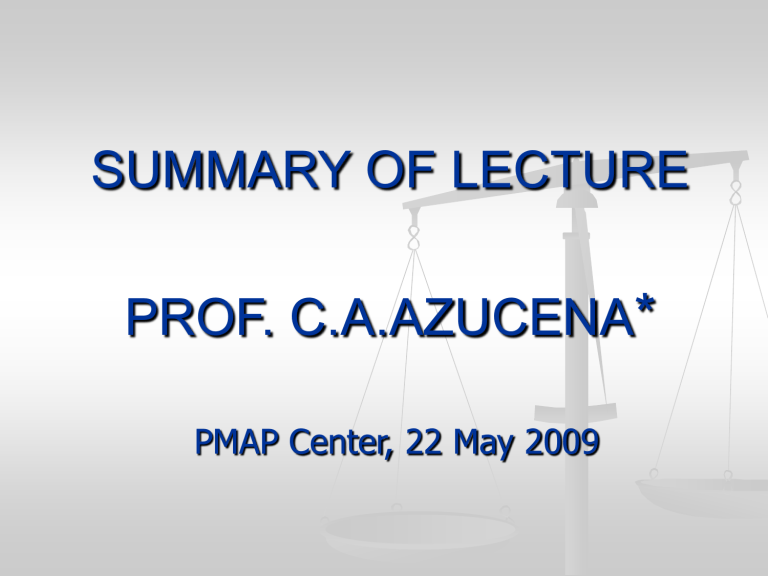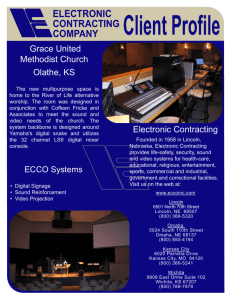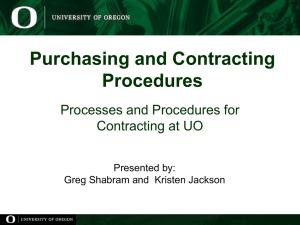SUMMARY OF LECTURE CC AZUCENA PMAP Center, May 22, 2009

SUMMARY OF LECTURE
PROF. C.A.AZUCENA
*
PMAP Center, 22 May 2009
THREE INTERLINKED ISSUES
1. Employment Relationship
2. Outsourcing/Labor Contracting
3. Employee’s Status
1.
Employer – employee relationship and contractorship are incompatible. If one is a legitimate contractor, he is not an employee.
The Labor Code does not apply.
2.
A legitimate contractor is himself an employer if he hires workers. He is direct employer; the contractee/principal is indirect employer. The
Labor Code applies.
3.
If the worker is not a legitimate contractor he is perhaps an employee. Or something else -- a co-owner, a partner, a volunteer. Employment and contractorship are incompatible, but they are not exact opposites.
4.The recognized determinants of employer-employee relationship comprise the four-fold test: a) hiring b) compensation (salary or wage) c) power to dismiss d) power of supervision and control.
The 4th factor is of first importance. But “economic dependence” test may also apply. (Not explained in Labor
Code or IRR; see court decisions)
5.
The recognized determinants or requisites of legitimate contractorship are: a. substantial capital b. independent business; hence, not supervised or controlled by the principal as to manner or method of doing the contracted work; c. the subject of the contract is the performance or completion of an identified job, hence, legitimate contracting is job contracting. (See D.O. No. 18-02 and court decisions)
6. Under present law the kind of work (core or noncore), place of work, basis of pay (time, piece, or job) are not determinants of either employment or contractorship.
7. If the determinants of legitimate contracting are absent, there is no contracting. There may be employment relationship. “Labor only contracting” is false contracting because it does not meet the requisites of legitimate contracting.
8. Legitimate contracting or outsourcing is legal. False contracting is illegal because it is an employment avoidance scheme that defeats labor rights.
9. Where employment relationship exists, employee rights exist. Outsourcing is legal but problematic where contractor-employer violates labor laws.
10. Like the participatory right, the right to security of tenure (ST) is guaranteed by the
Constitution and the Labor Code to all employees: regular or non-regular, managerial or nonmanagerial, in big or small enterprises. Job is livelihood; tenurial right assures lifeblood flow.
Law is strict against cutting off this lifeblood artery.
11. Right to ST means the right not to be removed from the job except for a valid reason (“just” under Art. 282,”authorized” mostly under Art. 283-284)
12. A regular (no-definite period) employee has right to ST for an indefinite period. A definite-period employee (project, seasonal, fixed term, casual) has right to ST for that definite period.
13. Definite-period employment requires definition of, and clear agreement about, that definite period. Agreement is made, knowingly and freely, at the time of hiring.
14. Preceding number applies to probationary employee who, also, must pass defined performance standards. Likewise applicable are the valid (“just” or “authorized”) causes of termination.
15. The FIRST LAW to observe in labormanagement relations is the first article on Human
Relations in the Civil Code: “Every person must, in the exercise of his rights and in the performance of his duties, act with justice, give everyone his due, and observe honesty and good faith.” (Article 19)
*Author: “Everyone’s Labor Code”; “The Labor Code with Comments and Cases” etc.
Chairman: Labor Law Department, School of Law,
Ateneo de Manila University.
Bar Reviewer: U.P. Law Center
“Noted Labor Law Expert” (Supreme Court in Toyota
Motor Philippine Corp vs. NLRC, Oct. 19, 2007)








